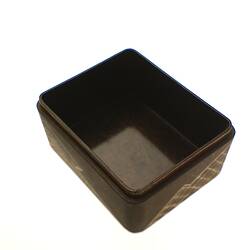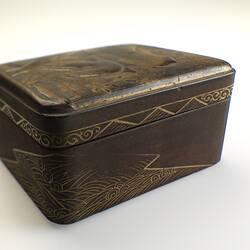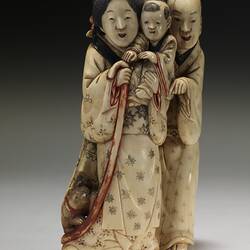Summary
Maki-e lacquer box with a representation of a pheasant on a rock, manufactured in Japan in the early Meiji period (1868-1880).
In Japanese art, the pheasant represents nobility and can be used to signify wealth or plenty, masculine strength and courage. Similar associations are made in Chinese theatre, where the pheasant is often used to represent ancient military figures on stage.
Such associations would be used on products designed for men, and this lacquer box may have been used as a cigar case. Chuji Nishiwaki exhibited a range of lacquered cigar cases at the 1880 Melbourne International Exhibition under class 29, including Leather-work, Fancy Articles, and Basket-work. Nishiwaki's exhibits, manufactured in Fukui in Japan, won the fifth order of Merit for lacquered ware in Jury Section 14.
Maki-e lacquering is a Japanese technique of sprinkling fine gold or silver powder into a design laid out in lacquer, using small brushes or bamboo tubes to create fine, often highly detailed and intricate designs. Other metals could be employed to achieve different colours, such as brass, copper, plantinum, pewter, as well as other alloys. The technique was first developed during the Heian period (794-1185) and flourished as a decorative style during the Edo period (1600-1868).
The beautiful decorative work of maki-e lacquer ware, combined with the increasing interest in the West of things Japanese, made such items as this incredibly popular for export markets. One advertisement, appearing in Melbourne's Argus newpaper in December 1880 some months after the International Exhibition had opened, promoted the sale of Japanese art exhibits 'just arrived from Japan. Collected specially by a gentleman resident in Japan for 14 years, for the Melbourne International Exhibition, but shut out in consequence of arriving too late for admission.'
Physical Description
Round cornered rectangular box. Lid decorated with relief pheasant on rock. Evidence of gilding around box body. No markings.
More Information
-
Collection Names
-
Collecting Areas
-
Acquisition Information
Cultural Gifts Donation from Dr Will Twycross, 23 Jan 2009
-
Acknowledgement
Donated through the Australian Government's Cultural Gifts Program
-
Place & Date Made
Japan, 1868-1880
early Meiji Period; Edo Period, 1603-1867; Meiji Period, 1868-1912 -
Place & Date Exhibited
Royal Exhibition Building (REB), Melbourne, Greater Melbourne, Victoria, Australia, 1880-1881
-
Collector
Mr John Twycross, Elsternwick, Greater Melbourne, Victoria, Australia, 1880
-
Classification
Royal exhibition building, International exhibitions, Exhibition heritage
-
Category
-
Discipline
-
Type of item
-
Overall Dimensions
115 mm (Width), 90 mm (Depth), 55 mm (Height)
-
Maximum dimensions
105 mm (Length), 85 mm (Width), 55 mm (Height)
Measurement From Conservation.
-
Keywords
Exhibitions: Melbourne International, 1880-1881, Japanese Art, Japanese Culture, Lacquerware, Royal Exhibition Building, Royal Exhibition Building: History of Events, 1879-1899






